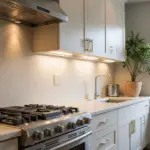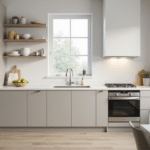The kitchen—a space where chaos often reigns supreme. Cluttered countertops, overflowing cabinets, and the constant visual noise of mismatched appliances can transform what should be a sanctuary into a source of daily stress. But imagine stepping into your kitchen and feeling a wave of calm wash over you instead.
This is the promise of minimalist kitchen ideas—not sterility or emptiness, but intentional design that creates both visual harmony and practical functionality. As someone who has designed tropical modern spaces where indoor and outdoor living merge seamlessly, I’ve discovered that minimalism works brilliantly in even the most vibrant environments. The challenge lies in striking that perfect balance between simplicity and warmth, functionality and beauty.
Let’s explore 22 minimalist kitchen ideas that will transform your cooking space into an oasis of calm productivity—where everything has its place and design speaks through thoughtful restraint rather than excess.
1. Clear the Clutter: Reclaim Your Countertops for a Serene Kitchen
The journey toward a minimalist kitchen begins where your eyes first land—your countertops. These horizontal planes set the visual tone for your entire space. When cluttered with appliances, mail, and miscellaneous items, they create immediate visual tension. Clearing these surfaces isn’t just about aesthetics; it fundamentally changes how you experience your kitchen.

Consider the psychological impact: studies consistently show that cluttered environments increase cortisol levels (the stress hormone). By clearing your countertops, you’re not just creating visual space—you’re creating mental space. Start by removing everything, then thoughtfully return only what you use daily. For everything else, find dedicated storage or consider whether you truly need it at all.
“The countertop is the canvas upon which your kitchen’s story unfolds. Keep it clear, and you’ll write a tale of calm rather than chaos.”
The magic of this transformation reveals itself when morning light filters through, casting clean shadows across uninterrupted surfaces rather than navigating a maze of objects. Beyond aesthetics, cooking becomes more intuitive when you have room to move, chop, and create without constantly shuffling items around.
2. Hideaway Havens: Embrace Hidden Storage for a Seamless Minimalist Look
Unlike traditional kitchens where everything is on display, the sustainable luxury of minimalist kitchen ideas embraces the concept that some things simply work better behind closed doors. Hidden storage solutions transform how a kitchen functions while maintaining clean visual lines.

The unexpected environmental benefit comes from thoughtful planning—when everything has a designated place, you’re less likely to purchase duplicates or unnecessary items. Consider pull-out pantries that utilize vertical space efficiently, appliance garages that keep small machines accessible but concealed, and drawer-within-drawer systems that maximize every cubic inch. These solutions aren’t just practical—they’re transformative, allowing your kitchen to breathe visually while still containing everything you need.
- Install toe-kick drawers beneath cabinets for rarely-used items
- Consider hydraulic lift-up cabinet doors for upper storage
- Utilize corner cabinet solutions like Le Mans systems to eliminate dead space
- Implement finger-pull or push-to-open mechanisms to eliminate hardware
As morning light filters through your kitchen window, these concealed storage solutions allow the architecture of your space to take center stage rather than the inevitable accumulation of kitchen tools and ingredients.
3. Neutral Nirvana: Discover the Power of Calm Color Palettes in Minimalist Kitchens
The color story emerging in minimalist kitchen ideas speaks through whispers rather than shouts. While many assume minimalist kitchens must be stark white, the truth offers far more nuance. The most successful minimalist kitchens embrace a sophisticated palette of neutrals—warm taupes, soft grays, muted earth tones—that create depth without overwhelming the senses.

In tropical contemporary design, I often incorporate neutrals that reference natural materials: the warm beige of seagrass, the soft gray of weathered driftwood, or the creamy white of coral stone. These colors create a sensory foundation that allows texture and light to become the true decorative elements. The interplay between these subtle tones creates visual interest without competing for attention, allowing the mind to rest rather than constantly process new visual information.
“Color in a minimalist kitchen should feel like the perfect temperature—you shouldn’t notice it’s there, but you’d certainly notice if it were wrong.”
When selecting your neutral palette, consider how natural light moves through your space throughout the day. North-facing kitchens benefit from warmer neutrals that compensate for cooler light, while south-facing spaces can handle cooler tones without feeling cold or clinical.
4. Lines That Speak Volumes: The Beauty of Simple, Clean Lines in Minimalist Design
The craftsmanship reveals itself in details like perfectly aligned cabinet fronts, seamless countertop edges, and the thoughtful repetition of horizontal and vertical elements in minimalist kitchen ideas. These clean lines aren’t merely aesthetic choices—they create visual pathways that guide the eye through the space without interruption, producing a sense of order that registers subconsciously.

In tropical modern design, I balance these strict geometries with subtle organic elements—perhaps a gently curved faucet or the natural grain pattern in wood cabinetry. This creates a dialogue between precision and nature that prevents minimalist spaces from feeling cold or impersonal. The key lies in maintaining visual discipline while allowing small moments of controlled variation that add character without chaos.
- Choose flat-panel cabinet doors without ornate details
- Align cabinet heights to create continuous horizontal lines
- Select fixtures with simple, geometric profiles
- Maintain consistent spacing between elements for visual rhythm
The magic of this approach becomes evident when evening light filters through the space, casting long shadows that emphasize these intentional lines rather than highlighting clutter or visual inconsistencies.
5. Appliance Minimalism: Opt for Streamlined Appliances for a Sleek Kitchen Aesthetic
The unexpected environmental benefit comes from choosing appliances that prioritize longevity and energy efficiency alongside aesthetics. Today’s streamlined appliances aren’t just visually quieter—they’re often designed with sustainability in mind, using less energy and water while lasting longer than their feature-heavy counterparts.

When selecting appliances for minimalist kitchen ideas, look beyond surface-level aesthetics to functional minimalism. This means choosing models with intuitive interfaces rather than complicated control panels, prioritizing quality construction over trendy features, and selecting items that perform multiple functions to reduce the total number of appliances needed. Panel-ready refrigerators and dishwashers that disappear into cabinetry create visual continuity, while induction cooktops offer sleek profiles with superior energy efficiency.
“The best appliances in a minimalist kitchen are like good service at a fine restaurant—they perform flawlessly while drawing minimal attention to themselves.”
The sustainable innovation narrative continues with smart appliances that optimize energy use based on your habits, reducing both environmental impact and utility bills while maintaining the clean aesthetic that defines minimalist kitchen ideas.
6. Open Shelving, Open Mind: Minimalist Shelving to Showcase Essentials, Not Clutter
The artisan’s journey behind handcrafted pieces often finds its perfect showcase on thoughtfully designed open shelving. Unlike traditional upper cabinets that can make spaces feel smaller, open shelving creates breathing room while providing opportunities for intentional display in minimalist kitchen ideas.

The key to successful open shelving lies not in what you put on it, but in what you leave off. Each item should earn its place through both functionality and beauty. This curated approach transforms everyday objects—handmade ceramic bowls, wooden cutting boards with beautiful grain patterns, or simple glassware—into elements of your design rather than mere tools. In tropical modern spaces, I often incorporate shelving made from sustainable materials like reclaimed wood or bamboo, adding warmth while maintaining clean lines.
- Group similar items together for visual cohesion
- Leave negative space between objects to prevent visual clutter
- Choose items with similar color tones or complementary materials
- Rotate seasonal items to keep the display fresh and functional
The craftsmanship reveals itself in the thoughtful placement of each object, creating compositions that feel intentional rather than accidental—a hallmark of successful minimalist kitchen ideas.
7. Light and Shadow: Integrate Lighting for a Warm and Minimalist Kitchen Ambiance
The emotional response this evokes begins with the first morning light filtering through your kitchen, transformed by thoughtfully placed fixtures that create layers of illumination rather than flat, uniform brightness. Lighting in minimalist kitchen ideas serves as both functional necessity and sculptural element, defining spaces and creating atmosphere without adding visual clutter.

In tropical contemporary design, I approach lighting as a way to highlight textures and create rhythm throughout the day. Recessed lighting provides even, ambient illumination, while simple pendant lights over islands or dining areas create focal points without visual complexity. Under-cabinet lighting not only serves practical purposes but creates a floating effect that enhances spatial perception. The most successful minimalist kitchens incorporate dimmers throughout, allowing the mood to shift from bright and energizing in the morning to soft and relaxing in the evening.
“Light in a minimalist kitchen should feel as natural as breathing—present but unnoticed until you need it, then perfectly attuned to your needs.”
The silhouette draws inspiration from natural light patterns, creating a seamless transition between day and night while maintaining the serene quality that defines minimalist kitchen ideas.
8. Beauty in Function: Choose Decor That Serves a Purpose in Your Minimalist Kitchen
The designer’s secret here is to select items that pull double duty—beautiful enough to display but functional enough to justify their presence in minimalist kitchen ideas. This approach transforms utilitarian objects into design elements without adding unnecessary clutter.

Consider a handcrafted wooden cutting board with beautiful grain patterns that serves as both preparation surface and serving platter. Or a collection of hand-thrown ceramic bowls in complementary neutral tones that stack neatly when stored but create an artistic arrangement when displayed. Even kitchen textiles can contribute to your design when selected in coordinating hues that reference your overall color palette. The magic happens when these functional objects create visual harmony without sacrificing their practical purpose.
- A mortar and pestle in natural stone serves as both tool and sculpture
- Copper or brass utensils develop beautiful patinas while remaining useful
- Handwoven baskets provide storage while adding texture
- Glass containers display ingredients while keeping them fresh
The composition comes together when you view your kitchen not as a collection of tools but as a carefully curated space where beauty and function are equally valued—the essence of minimalist kitchen ideas.
9. Hardware Harmony: Select Streamlined Hardware Choices for a Cohesive Minimalist Kitchen
The material sourcing makes all the difference in how hardware contributes to minimalist kitchen ideas. Unlike ornate traditional hardware that calls attention to itself, minimalist hardware serves as subtle punctuation in your kitchen’s visual sentence—present but not dominant, functional but refined.

In tropical modern design, I often select hardware that references natural elements—perhaps thin leather pulls that develop a beautiful patina over time, or simple wooden knobs that add warmth without visual complexity. Alternatively, integrated handles milled directly into cabinet fronts eliminate hardware entirely while maintaining functionality. The key is consistency—whether you choose minimal bar pulls, push-to-open mechanisms, or edge pulls, maintaining the same style throughout creates visual harmony that supports the minimalist aesthetic.
“Hardware in a minimalist kitchen should be like perfect seasoning in a well-prepared dish—it enhances the experience without drawing attention to itself.”
The unexpected environmental benefit comes from choosing quality hardware made from sustainable materials, designed to last decades rather than years—another way minimalist kitchen ideas support both aesthetic and ecological goals.
10. Container Clarity: Utilize Uniform Jars and Containers for a Visually Appealing Pantry
The visual weight balances perfectly when pantry contents are housed in matching containers, transforming the chaos of commercial packaging into a composed arrangement that satisfies both aesthetic and practical needs in minimalist kitchen ideas. This approach isn’t merely decorative—it fundamentally changes how you interact with your ingredients.

Clear glass containers allow you to assess inventory at a glance, reducing food waste and unnecessary purchases. Uniform shapes maximize storage efficiency while creating visual calm. In tropical contemporary spaces, I often recommend amber glass for items that need protection from light, and simple wooden lids that add warmth while maintaining the clean aesthetic. The transformation extends beyond appearance—decanting ingredients into proper storage containers often preserves freshness longer than original packaging.
- Select container sizes appropriate for your cooking habits
- Use consistent labeling that complements your aesthetic
- Group similar items together for visual cohesion
- Choose stackable designs to maximize vertical space
The heritage technique gets a contemporary update through this systematic approach to pantry organization—a perfect example of how minimalist kitchen ideas improve both form and function simultaneously.
11. Reach New Heights: Implement Vertical Storage Solutions to Maximize Minimalist Kitchen Space
The unexpected environmental benefit comes from making better use of existing space rather than expanding your kitchen’s footprint—a core principle behind sustainable minimalist kitchen ideas. By thinking vertically, you can store more in less space while maintaining the clean, uncluttered surfaces that define minimalist design.

Consider floor-to-ceiling cabinetry that eliminates the dust-collecting gap between cabinets and ceiling. Wall-mounted magnetic strips keep knives accessible without cluttering countertops. Vertical dividers transform cabinets into efficient storage for cutting boards and baking sheets. Even the sides of cabinets can become functional space with slim pull-out pantries or towel bars. In tropical modern kitchens, I often incorporate tall, narrow storage elements that reference architectural features while providing practical storage.
“Vertical thinking in a minimalist kitchen transforms spatial limitations into design opportunities, creating order from potential chaos.”
The design language evolved from traditional patterns that emphasized horizontal surfaces to contemporary approaches that recognize the full three-dimensional potential of kitchen spaces—a fundamental shift that supports both aesthetic and functional goals in minimalist kitchen ideas.
12. Double Duty Design: Consider Multi-Functional Furniture for Small Minimalist Kitchens
The craftsmanship reveals itself in details like a kitchen island that transforms from prep space to dining table, or a banquette that provides both seating and hidden storage. These multi-functional elements are particularly valuable in smaller kitchens, where minimalist kitchen ideas must work harder to create both visual spaciousness and practical functionality.

In tropical contemporary design, I often incorporate elements like built-in bench seating with storage drawers beneath, rolling carts that serve as both prep surface and serving station, or wall-mounted tables that fold down when needed and disappear when not in use. The beauty of these solutions lies in their ability to adapt to changing needs without compromising the clean aesthetic that defines minimalism. By eliminating single-purpose items, you reduce visual clutter while increasing functionality—a win-win for small spaces.
- Consider nesting tables that can expand for guests
- Look for cutting boards designed to fit over sinks for extra prep space
- Invest in adjustable-height surfaces that serve multiple functions
- Explore modular seating that can be reconfigured as needed
The interplay between the colors creates visual interest while the multi-functionality of each piece ensures that nothing is superfluous—a perfect embodiment of minimalist kitchen ideas that prioritize both form and function.
13. Nature’s Touch: Incorporate Natural Materials for a Minimalist and Organic Feel
The environmental story behind this piece began with the recognition that minimalist kitchen ideas needn’t feel cold or sterile. Natural materials add warmth, texture, and tactile pleasure while maintaining clean lines and simple forms. They create sensory richness without visual complexity—a perfect balance for minimalist spaces.

In tropical modern design, I incorporate materials like FSC-certified woods, natural stone with interesting but subtle veining, handwoven textiles in neutral tones, and elements like cork or rattan that reference natural environments. These materials develop character over time, acquiring patinas that tell the story of your kitchen’s life. The sustainable journey of these materials involves choosing options that are responsibly sourced, durable enough to last generations, and able to be recycled or biodegraded at the end of their useful lives.
“Natural materials in a minimalist kitchen are like old friends—comfortable, reliable, and more beautiful with age.”
The magic of this piece lies in its ability to connect us to nature even in the most contemporary settings—a fundamental principle of biophilic design that enhances well-being while supporting the aesthetic goals of minimalist kitchen ideas.
14. Light It Up (Simply): Choose Statement Lighting That Enhances Minimalist Kitchen Style
The silhouette draws inspiration from natural forms while maintaining clean lines in statement lighting for minimalist kitchen ideas. Unlike traditional kitchens where decorative elements might appear throughout the space, minimalist kitchens often rely on lighting as the primary sculptural element—the exclamation point in an otherwise restrained design sentence.

In tropical contemporary spaces, I select lighting fixtures that create drama through form rather than ornamentation. Perhaps a series of simple globe pendants at varying heights, a linear suspension light that echoes the clean lines of the island below, or a single oversized fixture that anchors the space without visual clutter. The key is choosing pieces with strong, simple silhouettes that complement rather than compete with the architecture of your kitchen. Materials matter too—handblown glass, brushed metals, or natural fibers add texture and interest without excessive detail.
- Position statement lighting where it creates both function and visual focus
- Choose fixtures with dimmable capabilities for flexibility
- Consider the scale of the fixture in relation to your space
- Look for quality construction that will stand the test of time
The unexpected pairing that always works is architectural minimalism with thoughtfully chosen statement lighting—creating focal points that draw the eye without disrupting the serene quality that defines successful minimalist kitchen ideas.
15. Work Smarter, Not Harder: Explore Smart Storage Solutions for a Minimalist Kitchen Workflow
The designer’s attention to detail shows in how smart storage solutions transform not just the appearance but the functionality of minimalist kitchen ideas. Unlike conventional storage that simply provides space, smart storage anticipates needs and creates intuitive workflows that make cooking more efficient and enjoyable.

Consider drawer dividers custom-sized for your utensils and tools, pullout systems that bring the contents of deep cabinets within easy reach, or specialized storage for items like cutting boards, baking sheets, and lids. In tropical modern kitchens, I incorporate elements like cooling drawers for produce that eliminate the need for countertop fruit bowls, integrated knife blocks within drawers that keep sharp edges safely stored but accessible, and custom spice storage that organizes ingredients by cuisine or frequency of use.
“The true luxury in a minimalist kitchen isn’t expansive countertops or expensive appliances—it’s having everything you need exactly where you need it, when you need it.”
The sustainable journey of this material involves reducing waste by making everything visible and accessible, preventing forgotten ingredients and reducing duplicate purchases—another way minimalist kitchen ideas support both aesthetic and environmental goals.
16. Drawer Detox: Declutter Drawers and Cabinets for a Truly Minimalist Kitchen Experience
The artisans’ commitment to environmental practices means evaluating every item in your drawers and cabinets with both honesty and intention. This internal decluttering may be less visible than countertop clearing, but it’s equally essential to achieving true minimalist kitchen ideas that function as beautifully as they look.

Begin by emptying each drawer completely, cleaning the interior, and sorting contents into categories: essential daily items, occasional-use tools, duplicates, and items you haven’t used in over a year. Be ruthless with the last two categories—duplicates can be donated, and unused items are taking up valuable space. For items you keep, invest in drawer organizers that prevent the slow creep of chaos that occurs when items shift during opening and closing. In tropical contemporary design, I often use sustainable materials like bamboo or recycled plastic for these organizational elements.
- Implement the “one in, one out” rule for kitchen tools
- Store seasonal items elsewhere to free up prime kitchen real estate
- Group similar items together for logical access
- Reassess your drawer organization quarterly to prevent backsliding
The maker’s journey from apprentice to master influenced this methodical approach to internal organization—understanding that what’s hidden affects the overall function as much as what’s visible in minimalist kitchen ideas.
17. Backsplash Simplicity: Opt for Minimalist Backsplash Ideas for a Clean and Modern Kitchen
The material sourcing makes all the difference in how a backsplash contributes to minimalist kitchen ideas. Unlike traditional kitchens with decorative tile patterns, minimalist backsplashes create impact through material quality and thoughtful detailing rather than busy designs.

In tropical modern spaces, I often select large-format tiles or slabs that minimize grout lines, creating cleaner visual planes. Materials like honed marble with subtle veining, textured glass in neutral tones, or even concrete finishes provide interest without complexity. The key is choosing materials that complement your countertops and cabinetry while offering the practical benefits of durability and easy cleaning. For truly minimalist approaches, consider continuing your countertop material up the wall as a backsplash, creating seamless visual flow.
“A minimalist backsplash should be like perfect background music—enhancing the experience without demanding attention.”
The unexpected environmental benefit comes from choosing natural materials that age beautifully rather than trendy options that you’ll want to replace in a few years—another way minimalist kitchen ideas support sustainability through longevity.
18. Sink Serenity: Select Streamlined Sink and Faucet Choices for a Minimalist Kitchen Oasis
The design language evolved from traditional patterns that emphasized decorative details to contemporary approaches focused on pure function and clean lines in minimalist kitchen ideas. The sink and faucet, as frequently used elements, deserve particular attention in this evolution.

For sinks, consider undermount styles that create clean lines with countertops, single-bowl designs that provide maximum usable space, or integrated sinks formed from the same material as your countertop for seamless visual flow. In tropical contemporary design, I often select sinks with tight-radius corners that offer modern aesthetics while remaining easy to clean. For faucets, look for simple silhouettes with integrated functionality—perhaps a pull-down spray feature within a clean-lined design, or touch-activated operation that eliminates the need for handles when your hands are messy from cooking.
- Choose finishes that complement rather than contrast with your overall palette
- Consider wall-mounted faucets for easier counter cleaning
- Look for models with ceramic disc valves for longevity
- Select deep sinks that hide dishes when entertaining
The quality becomes evident after years of use when these carefully selected fixtures continue to function flawlessly while maintaining their aesthetic appeal—a hallmark of successful minimalist kitchen ideas.
19. Concealed Comfort: Integrate Range Hoods for a Seamless Minimalist Kitchen Design
The unexpected environmental benefit comes from modern range hood technology that operates more efficiently while maintaining the clean aesthetic essential to minimalist kitchen ideas. Unlike traditional hoods that dominate visual space, contemporary concealed options perform their function without disrupting design continuity.

Consider custom-built cabinetry that completely encloses the hood, integrated ceiling-mounted systems that eliminate the need for wall-mounted hoods entirely, or sleek, low-profile designs that minimize visual impact. In tropical modern kitchens, I often incorporate downdraft systems for island cooktops, eliminating overhead elements and maintaining open sightlines that connect indoor and outdoor spaces. The key is selecting systems with appropriate CFM ratings for your cooking style while prioritizing quiet operation—technical performance wrapped in minimalist aesthetics.
“The best range hood in a minimalist kitchen is one you barely notice—until you realize your kitchen never smells like last night’s fish.”
The sustainable journey of this material involves choosing energy-efficient models with LED lighting and programmable settings that operate only when needed—another way minimalist kitchen ideas support both aesthetic and environmental goals.
20. Essential Edit: Curate Your Cookware and Utensils for a Minimalist Kitchen Toolkit
The craftsmanship reveals itself in details like perfectly balanced chef’s knives, heavy-bottomed cookware that distributes heat evenly, and utensils designed for multiple uses rather than single functions. This curated approach to kitchen tools embodies the core philosophy behind minimalist kitchen ideas—that fewer, better things create more satisfaction than many mediocre ones.

Begin by assessing what you actually cook, not what you aspire to cook. A pasta machine used once a year doesn’t earn countertop or cabinet space. For items you use regularly, invest in the highest quality you can afford, selecting pieces that perform multiple functions when possible. In tropical contemporary design, I recommend cookware and tools with clean lines and natural materials—perhaps cast iron with simple styling, wooden utensils with minimal detailing, or knives with understated handles that feel good in the hand.
- Select multi-tasking tools like a chef’s knife that handles multiple cutting tasks
- Choose nesting cookware sets that store efficiently
- Invest in quality rather than quantity
- Consider the visual cohesion of your tools if they’ll be displayed
The unexpected pairing that always works is ruthless functionality with subtle beauty—creating a collection of tools that perform flawlessly while contributing to the overall aesthetic of minimalist kitchen ideas.
21. Out of Sight, Out of Mind: Integrate Trash and Recycling for a Clean Minimalist Kitchen Aesthetic
The environmental story behind this piece began with recognizing that waste management, while necessary, needn’t be visually prominent in minimalist kitchen ideas. Integrated solutions conceal these practical elements while often improving functionality through thoughtful organization.

Consider pull-out cabinet systems with separate bins for trash, recycling, and compost, making sorting intuitive and simple. Look for soft-close mechanisms that prevent slamming and extend the life of your cabinetry. In tropical modern design, I often incorporate ventilated compartments for compost to accommodate the organic waste from fruit and plant-based cooking common in tropical cuisines. The key is selecting systems proportioned appropriately for your household’s needs while maintaining the clean lines and hidden functionality that define minimalist aesthetics.
“The mark of truly successful minimalist kitchen ideas isn’t just what you see—it’s what you don’t see.”
The sustainable innovation narrative continues with waste management systems designed to make recycling and composting as effortless as possible—supporting environmental goals while maintaining the clean aesthetic that defines minimalist kitchen ideas.
22. Green Goodness: Add a Touch of Nature with Plants in a Minimalist Kitchen Setting
The tactile experience changes the entire room’s energy when living plants bring their gentle movement and organic forms into minimalist kitchen ideas. Unlike decorative objects that remain static, plants respond to their environment—growing, changing, and even purifying the air you breathe.

In tropical contemporary design, I select plants that thrive in kitchen conditions while complementing the minimalist aesthetic—perhaps a sculptural snake plant with strong vertical lines, a trailing pothos that softens cabinet edges, or herbs in simple containers that provide both visual and culinary pleasure. The key is choosing specimens with forms that echo your kitchen’s design language while requiring minimal maintenance. Consider placement carefully—perhaps a single statement plant on an otherwise empty counter, or small herbs grouped on a windowsill.
- Choose pots in materials that complement your kitchen finishes
- Select plants with similar care requirements for easier maintenance
- Consider edible options like herbs for both beauty and function
- Group plants with similar water needs together
The magic of this approach lies in how these living elements soften the potentially stark lines of minimalist kitchen ideas without adding clutter—creating a space that feels both ordered and alive.
Conclusion
The journey through these 22 minimalist kitchen ideas reveals a fundamental truth: minimalism isn’t about emptiness or deprivation—it’s about intentionality and elevation. By clearing physical clutter, we clear mental space. By choosing quality over quantity, we create environments that serve us better while demanding less from our planet’s resources.
The minimalist kitchen isn’t just a design trend; it’s a response to our increasingly complex world. It offers a daily sanctuary where functionality and beauty coexist in perfect balance. Whether you implement one idea or all twenty-two, each step toward minimalism creates space—both physical and mental—for what truly matters.
As you transform your kitchen, remember that minimalism looks different for everyone. Your minimalist kitchen should reflect your life, your cooking style, and your aesthetic preferences. The true measure of success isn’t how empty your kitchen is, but how perfectly it supports the way you live and the person you want to be.






